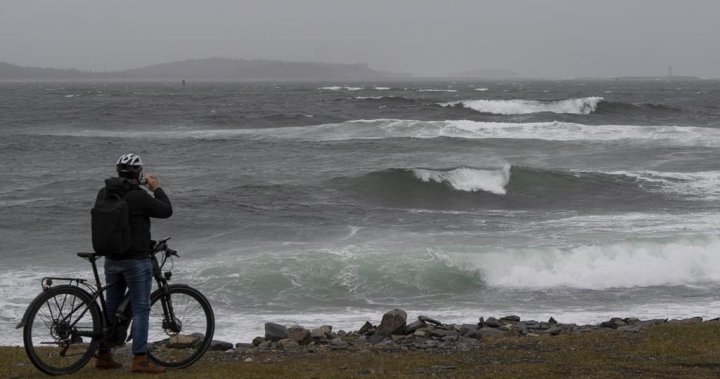Tens of 1000’s of houses and companies have been with out energy in New Brunswick and Nova Scotia on Tuesday after sturdy winds hit components of Canada’s East Coast.
It’s the second time in per week that damaging gusts have pulled down energy traces throughout the Maritimes.
Setting Canada had issued in a single day wind warnings for Nova Scotia and components of New Brunswick, with the winds anticipated to decrease through the day.
As of two p.m. native time, there have been 87,000 prospects in New Brunswick with out energy, and 31,000 with out energy in Nova Scotia. Electrical energy had been restored to most prospects in Prince Edward Island, and there have been about 210 prospects nonetheless with out energy in western Newfoundland.
Hours earlier, on the peak of the blackouts, 173,000 prospects throughout the Atlantic area have been with out energy.
Wind speeds reached over 100 kilometres per hour in some areas, similar to Eskasoni First Nation in Cape Breton and Greenwood, N.S., however the strongest winds in most components of the province have been extra within the vary of 80 to 90 km/h.
“The gusts in most areas of the province have been as much as excessive 80s and into the 90s,” on the peak, mentioned Ian Hubbard, an Setting Canada forecaster.
Get the most recent Nationwide information.
Despatched to your e-mail, daily.
The strongest wind velocity recorded in New Brunswick was 100 km/h on the Fredericton airport, whereas gusts in Saint John and St. Stephen have been as much as 93 km/h, he added.
Nonetheless, in Halifax the winds have been lighter, with gusts staying at lower than 70 km/h in additional sheltered areas, based on Setting Canada knowledge.
Volunteers at three Halifax-area homeless encampments, the place quite a lot of ice-fishing tents changed flimsier summer time tents, reported the constructions had weathered the storm with out harm. Nikki Greer, president of a non-profit society that assists homeless residents of a ball area in Decrease Sackville, mentioned there have been deep puddles on the grounds from the rain however “no important harm, and all residents are OK.”
The storm was the results of a low-pressure system assembly an enormous high-pressure system within the Atlantic Ocean, which created a slow-moving storm with sturdy winds.
In August, Nova Scotia’s privately owned electrical utility was fined $750,000 for failing to fulfill 2022 efficiency targets set by the provincial regulator.
The Nova Scotia Utility and Assessment Board mentioned Nova Scotia Energy Inc. had elevated investments in transmission infrastructure to cope with more and more highly effective storms however had failed to realize sure reliability targets in annually for the reason that requirements have been established in 2016.
“It’s not acceptable that non-compliance of the efficiency requirements has develop into a traditional prevalence,” the board mentioned on the time. “If extra frequent and damaging storms have gotten the ‘new regular,’ NS Energy wants to make sure that its efficiency, not simply its funding plans, retains up with these adjustments.”
Nonetheless, Matt Drover, the supervisor of storm response at Nova Scotia Energy, mentioned in an interview Tuesday that the utility has invested greater than $32 million in tree reducing and trimming this 12 months and that the work has been making a distinction, significantly round transmission traces.
It was the extended publicity to winds within the newest storm, he mentioned, that brought about timber to fall on energy traces.
“This can be a 36-hour storm that gained’t depart the province,” Dover mentioned. “It’s been hovering over there and people winds have been battering timber for that whole time and finally these timber simply fall on the ability line.”
The winds in final week’s storm have been strongest in Bridgewater and Halifax, whereas this week’s storm was strongest within the Annapolis Valley and northern Nova Scotia, Dover mentioned.
This report by The Canadian Press was first printed Dec. 19, 2023.
© 2023 The Canadian Press




